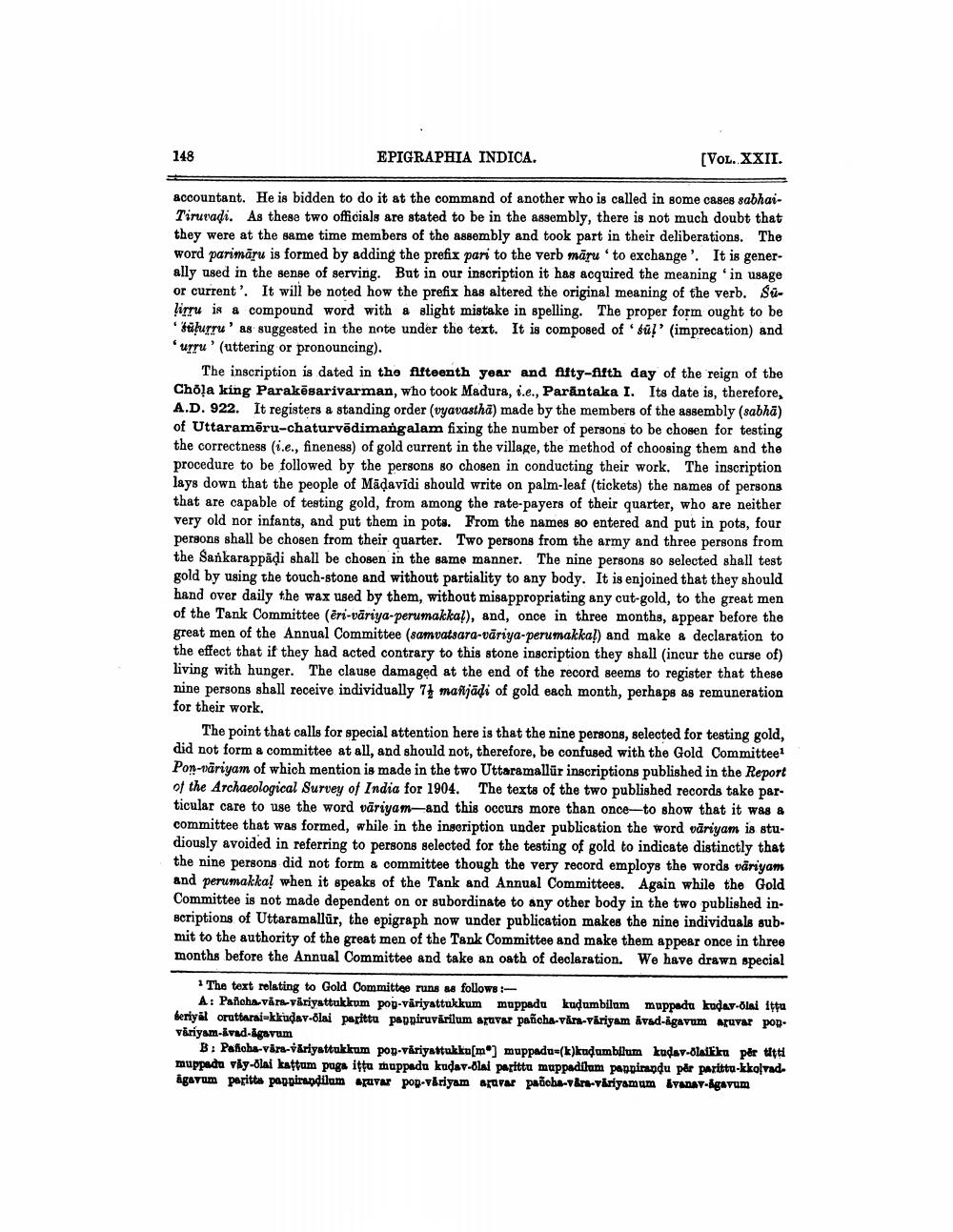________________
148
EPIGRAPHIA INDICA.
[VOL. XXII.
accountant. He is bidden to do it at the command of another who is called in some cases sabhaiTiruvadi. As these two officials are stated to be in the assembly, there is not much doubt that they were at the same time members of the assembly and took part in their deliberations. The word parimāru is formed by adding the prefix pari to the verb māru to exchange'. It is generally used in the sense of serving. But in our inscription it has acquired the meaning in usage or current'. It will be noted how the prefix has altered the original meaning of the verb. Süirru is a compound word with a slight mistake in spelling. The proper form ought to be taburru' as suggested in the note under the text. It is composed of su?' (imprecation) and 'urru' (uttering or pronouncing).
The inscription is dated in the fifteenth year and fifty-fifth day of the reign of the Chōla king Parakesarivarman, who took Madura, i.e., Parantaka I. Its date is, therefore, A.D. 922. It registers a standing order (vyavastha) made by the members of the assembly (sabhā) of Uttarameru-chaturvedimangalam fixing the number of persons to be chosen for testing the correctness (i.e., fineness) of gold current in the village, the method of choosing them and the procedure to be followed by the persons so chosen in conducting their work. The inscription lays down that the people of Maḍavidi should write on palm-leaf (tickets) the names of persons that are capable of testing gold, from among the rate-payers of their quarter, who are neither very old nor infants, and put them in pots. From the names so entered and put in pots, four persons shall be chosen from their quarter. Two persons from the army and three persons from the Sankarappadi shall be chosen in the same manner. The nine persons so selected shall test gold by using the touch-stone and without partiality to any body. It is enjoined that they should hand over daily the wax used by them, without misappropriating any cut-gold, to the great men of the Tank Committee (eri-väriya-perumakkal), and, once in three months, appear before the great men of the Annual Committee (samvatsara-väriya-perumakkal) and make a declaration to the effect that if they had acted contrary to this stone inscription they shall (incur the curse of) living with hunger. The clause damaged at the end of the record seems to register that these nine persons shall receive individually 7 mañjādi of gold each month, perhaps as remuneration for their work.
The point that calls for special attention here is that the nine persons, selected for testing gold, did not form a committee at all, and should not, therefore, be confused with the Gold Committee1 Pon-väriyam of which mention is made in the two Uttaramallür inscriptions published in the Report of the Archaeological Survey of India for 1904. The texts of the two published records take particular care to use the word variyam-and this occurs more than once-to show that it was a committee that was formed, while in the inscription under publication the word vāriyam is studiously avoided in referring to persons selected for the testing of gold to indicate distinctly that the nine persons did not form a committee though the very record employs the words väriyam and perumakkal when it speaks of the Tank and Annual Committees. Again while the Gold Committee is not made dependent on or subordinate to any other body in the two published inscriptions of Uttaramallür, the epigraph now under publication makes the nine individuals submit to the authority of the great men of the Tank Committee and make them appear once in three months before the Annual Committee and take an oath of declaration. We have drawn special
1 The text relating to Gold Committee runs as follows:
A: Pañcha-vara-väriyattukkum pop-väriyattukkum muppadu kudumbilum muppadu kudav-ōlai ittu seriyal oruttarai-kkudav-ölai parittu pappiruvärilum aruvar pañcha-vara-väriyam ävad-agavum aruvar pon
väriyam-ävad-ägavum
B: Pañicha-vara-väriyattukkum pop-väriyattukku[m] muppadu=(k)kudumbilum kudav-ölaikku për titti muppadu vay-olai kattum puga ittu muppadu kudav-ölai parittu muppadilum panpirandu par parittu-kkolvad. agavum paritta panpirandilum aruvar pop-väriyam aravar pañcha-vara-väriyamum &vanav-igavum




